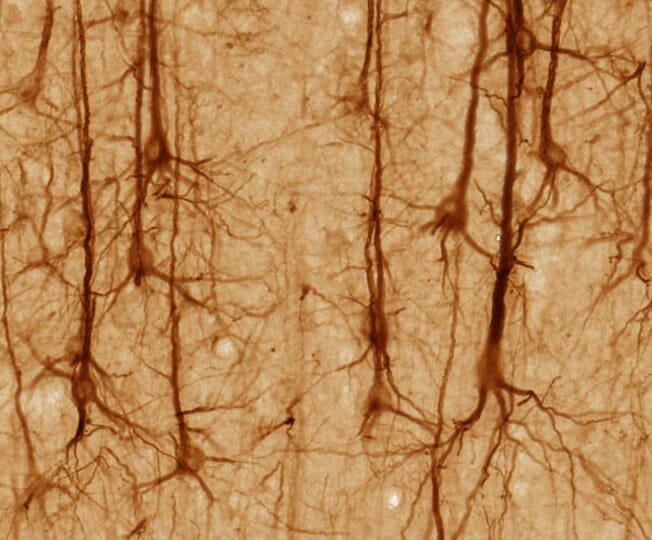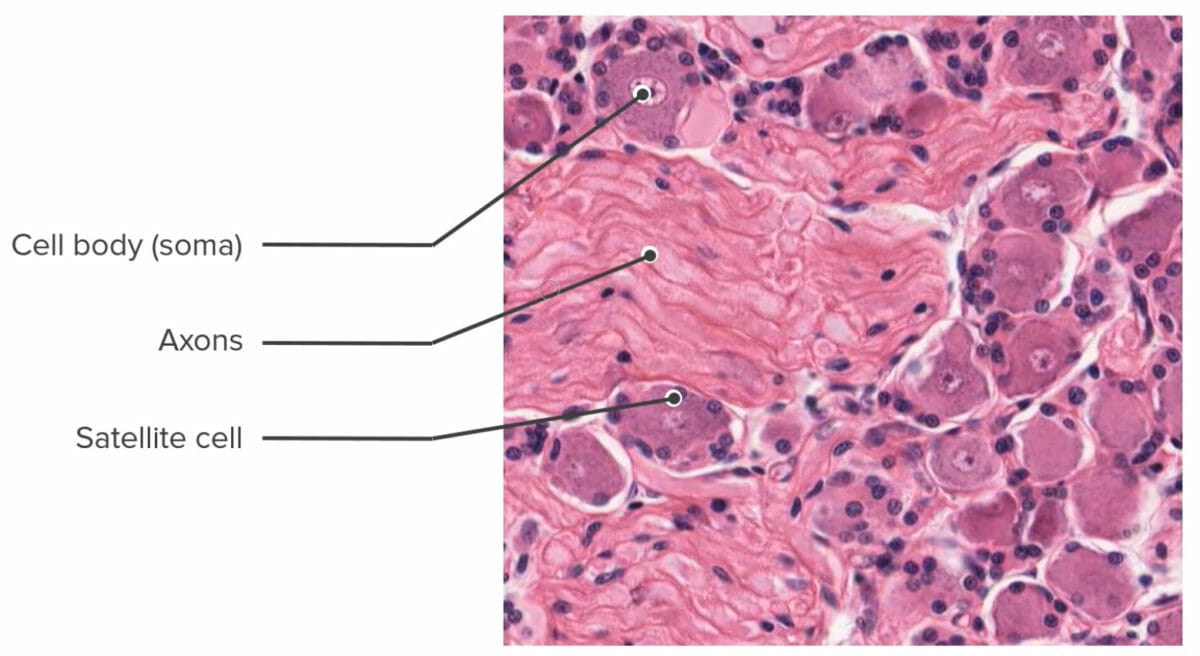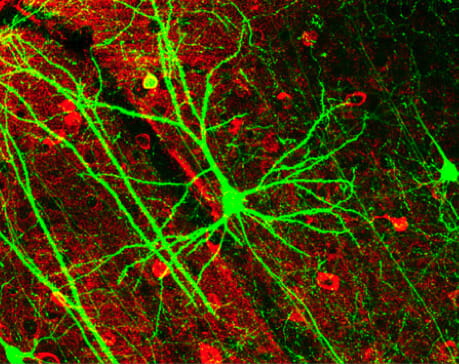Nerve tissue consists of 2 principal types of cells: neurons and supporting cells. The neuron is the structural and functional/electrically excitable unit of the nervous system Nervous system The nervous system is a small and complex system that consists of an intricate network of neural cells (or neurons) and even more glial cells (for support and insulation). It is divided according to its anatomical components as well as its functional characteristics. The brain and spinal cord are referred to as the central nervous system, and the branches of nerves from these structures are referred to as the peripheral nervous system. Nervous System: Anatomy, Structure, and Classification that receives, processes, and transmits electrical signals to and from other parts of the nervous system Nervous system The nervous system is a small and complex system that consists of an intricate network of neural cells (or neurons) and even more glial cells (for support and insulation). It is divided according to its anatomical components as well as its functional characteristics. The brain and spinal cord are referred to as the central nervous system, and the branches of nerves from these structures are referred to as the peripheral nervous system. Nervous System: Anatomy, Structure, and Classification via its cell processes. There are multiple types of neurons that are classified based on their anatomic structure and function as sensory neurons Sensory neurons Neurons which conduct nerve impulses to the central nervous system. Autonomic Nervous System: Anatomy, motor neurons, and interneurons. The functional components of a neuron include dendrites (to receive signals), a cell body (to drive cellular activities), an axon (to conduct impulses to target cells), and synaptic junctions (specialized junctions between neurons that facilitate the transmission of impulses between neurons; they are also found between axons and effector/target cells, such as muscle and gland cells). Supporting cells are called neuroglial cells and are located close to the neurons; however, these cells do not conduct electrical signals. The CNS consists of 4 types of glial cells: oligodendrocytes, astrocytes, microglia, and ependymal cells, each having a different function. In the PNS, the supporting cells are called peripheral neuroglia and include Schwann cells, satellite cells, and various other cells having specific structures and functions. Schwann cells surround the processes of nerve cells and isolate them from adjacent cells and the extracellular matrix Extracellular matrix A meshwork-like substance found within the extracellular space and in association with the basement membrane of the cell surface. It promotes cellular proliferation and provides a supporting structure to which cells or cell lysates in culture dishes adhere. Hypertrophic and Keloid Scars by producing a lipid-rich myelin sheath, ensuring the rapid conduction of nerve impulses. Satellite cells are similar to Schwann cells, but they surround the nerve cell bodies. In the CNS, oligodendrocytes produce and maintain the myelin sheath. A nerve is composed of a collection of bundles (or fascicles) of nerve fibers. Within the CNS, the brain Brain The part of central nervous system that is contained within the skull (cranium). Arising from the neural tube, the embryonic brain is comprised of three major parts including prosencephalon (the forebrain); mesencephalon (the midbrain); and rhombencephalon (the hindbrain). The developed brain consists of cerebrum; cerebellum; and other structures in the brain stem. Nervous System: Anatomy, Structure, and Classification and spinal cord Spinal cord The spinal cord is the major conduction pathway connecting the brain to the body; it is part of the CNS. In cross section, the spinal cord is divided into an H-shaped area of gray matter (consisting of synapsing neuronal cell bodies) and a surrounding area of white matter (consisting of ascending and descending tracts of myelinated axons). Spinal Cord: Anatomy tissue can be classified as gray or white matter White Matter The region of central nervous system that appears lighter in color than the other type, gray matter. It mainly consists of myelinated nerve fibers and contains few neuronal cell bodies or dendrites. Brown-Séquard Syndrome, depending on the tissue composition. White matter White Matter The region of central nervous system that appears lighter in color than the other type, gray matter. It mainly consists of myelinated nerve fibers and contains few neuronal cell bodies or dendrites. Brown-Séquard Syndrome is most notably composed of myelinated Myelinated Internuclear Ophthalmoplegia nerve fibers, whereas gray matter Gray matter Region of central nervous system that appears darker in color than the other type, white matter. It is composed of neuronal cell bodies; neuropil; glial cells and capillaries but few myelinated nerve fibers. Cerebral Cortex: Anatomy is made up of neuronal cell bodies.
Last updated: Sep 1, 2022
Neurons are:
Neurons consist of 3 main parts:
Dendrites:
Cell body:
Axon:
Neurons may be classified by the number of processes (axon and dendrites) attached to the cell body.
Multipolar neurons:
Bipolar neurons:
Pseudounipolar neurons:
Unipolar neurons:

Basic neuron types
Image by Lecturio.
Examples of multipolar neurons:
Pyramidal and Purkinje cells. Notice the multiple processes extending from the cell body.

Pyramidal neurons in the cerebral cortex stained with a monoclonal antibody to neurofilament protein (SMI32): The somas (bodies) appear almost triangular with multiple dendrites attached, which are connected to long axons.
Image: “SMI32-stained pyramidal neurons in cerebral cortex” by UC Regents Davis campus. License: CC BY 3.0Neurons may also be classified based on their functional role and the direction in which they transmit signals (toward or away from the CNS).
Sensory neurons Sensory neurons Neurons which conduct nerve impulses to the central nervous system. Autonomic Nervous System: Anatomy:
Motor neurons:
Interneurons:
Neuroglia, also known as glial cells, are the most abundant cells in the CNS.
Neuroglia can be classified based on their location within the nervous system Nervous system The nervous system is a small and complex system that consists of an intricate network of neural cells (or neurons) and even more glial cells (for support and insulation). It is divided according to its anatomical components as well as its functional characteristics. The brain and spinal cord are referred to as the central nervous system, and the branches of nerves from these structures are referred to as the peripheral nervous system. Nervous System: Anatomy, Structure, and Classification.

Types of neuroglia and their locations:
Ependymal cells are found only in the CNS and in small subarachnoid spaces, undertaking an epithelial-like function. Astrocytes supply neurons with nutrients and induce the formation of endothelial tight junctions, which play an important role in the
blood–brain barrier. They also fill the extracellular space of the CNS. Satellite cells are involved in the lining of the somas of neurons in the PNS. Schwann cells and microglia accelerate the rate of conduction.

Image showing 4 different types of glial cells in the CNS:
Ependymal cells (light pink), astrocytes (green), microglial cells (red), and oligodendrocytes (light blue; functionally similar to Schwann cells in the PNS)
Location:
Features:
Functions:

Astrocytes can be identified because, unlike other mature glia, they express glial fibrillary acidic protein (GFAP): Here, astrocytes were identified using anti-GFAP antibodies with a fluorescent label.
Image: “Glial cells” by Maksim. License: Public DomainLocation:
Features:
Functions:

Columnar ependymal cells lining the central canal of the spinal cord
Image: “Histological image (H&E) of the human central canal” by Erfanul Saker, Brandon M Henry, Krzysztof A Tomaszewski, Marios Loukas, Joe Iwanaga, Rod J Oskouian, and R. Shane Tubbs. License: CC BY 3.0Unlike most neuroglia (which are derived from the neuroectoderm Neuroectoderm Development of the Nervous System and Face), microglia are immune cells derived from the mesoderm Mesoderm The middle germ layer of an embryo derived from three paired mesenchymal aggregates along the neural tube. Gastrulation and Neurulation.
Location:
Features:
Functions:
The neuroglia listed below produce myelin but differ in their location within the nervous system Nervous system The nervous system is a small and complex system that consists of an intricate network of neural cells (or neurons) and even more glial cells (for support and insulation). It is divided according to its anatomical components as well as its functional characteristics. The brain and spinal cord are referred to as the central nervous system, and the branches of nerves from these structures are referred to as the peripheral nervous system. Nervous System: Anatomy, Structure, and Classification.
Oligodendrocytes:
Schwann cells:
Myelin sheath:

Myelination of an axon:
Rotation of the Schwann cell around the axon forms an envelope of myelin sheath around the axon.

Low-magnification electron micrograph shows a satellite glial cell sheath (red) enveloping a sensory neuron.
N1: sensory neuron
s: satellite glial cell sheath
v: blood vessel
N2, N3, N4: adjacent neurons
ct: connective tissue space
Nerve fibers are the axons of neurons and can be classified based on the presence/absence of a myelin sheath.
Myelinated Myelinated Internuclear Ophthalmoplegia:
Unmyelinated:

Electron microscope image of a myelinated axon: The thick, black structure surrounding the axon is the myelin sheath, which is formed by a Schwann cell.
Image by Lecturio.
Electron microscope image of an unmyelinated nerve fiber. Notice that a Schwann cell is associated with multiple axons, but these axons are not myelinated.
Image by Lecturio.
Histology of peripheral nerves demonstrating the different layers of connective tissue: The epineurium is the outermost layer, the perineurium surrounds the nerve fascicle, and the endoneurium (innermost layer) surrounds individual myelinated axons (or groups of unmyelinated axons).
Image by Lecturio.
Cross-section of a nerve: The top figure (a) demonstrates the different components and layers within a peripheral nerve. These components are also visualized in a histologic specimen (b).
Image: “Cross-section of a nerve” by OpenStax College – Anatomy & Physiology. License: CC BY 3.0The neuronal cell bodies of nerve fibers can reside in the CNS ( brain Brain The part of central nervous system that is contained within the skull (cranium). Arising from the neural tube, the embryonic brain is comprised of three major parts including prosencephalon (the forebrain); mesencephalon (the midbrain); and rhombencephalon (the hindbrain). The developed brain consists of cerebrum; cerebellum; and other structures in the brain stem. Nervous System: Anatomy, Structure, and Classification, spinal cord Spinal cord The spinal cord is the major conduction pathway connecting the brain to the body; it is part of the CNS. In cross section, the spinal cord is divided into an H-shaped area of gray matter (consisting of synapsing neuronal cell bodies) and a surrounding area of white matter (consisting of ascending and descending tracts of myelinated axons). Spinal Cord: Anatomy, or cranial nerve ganglia) or in the PNS (peripheral ganglia).
General:
Some major types of peripheral ganglia:

High-power photomicrograph of a histologic section of a dorsal root ganglion (hematoxylin and eosin staining)
Image by Lecturio.
Histology image of a sympathetic ganglion
Image by Lecturio.
Histology image of an enteric ganglion
Image by Geoffrey Meyer, edited by Lecturio.The tissue of the CNS ( brain Brain The part of central nervous system that is contained within the skull (cranium). Arising from the neural tube, the embryonic brain is comprised of three major parts including prosencephalon (the forebrain); mesencephalon (the midbrain); and rhombencephalon (the hindbrain). The developed brain consists of cerebrum; cerebellum; and other structures in the brain stem. Nervous System: Anatomy, Structure, and Classification and spinal cord Spinal cord The spinal cord is the major conduction pathway connecting the brain to the body; it is part of the CNS. In cross section, the spinal cord is divided into an H-shaped area of gray matter (consisting of synapsing neuronal cell bodies) and a surrounding area of white matter (consisting of ascending and descending tracts of myelinated axons). Spinal Cord: Anatomy) has a characteristic classification as white or gray matter Gray matter Region of central nervous system that appears darker in color than the other type, white matter. It is composed of neuronal cell bodies; neuropil; glial cells and capillaries but few myelinated nerve fibers. Cerebral Cortex: Anatomy.
Gray matter Gray matter Region of central nervous system that appears darker in color than the other type, white matter. It is composed of neuronal cell bodies; neuropil; glial cells and capillaries but few myelinated nerve fibers. Cerebral Cortex: Anatomy generally makes up the external layer of the brain Brain The part of central nervous system that is contained within the skull (cranium). Arising from the neural tube, the embryonic brain is comprised of three major parts including prosencephalon (the forebrain); mesencephalon (the midbrain); and rhombencephalon (the hindbrain). The developed brain consists of cerebrum; cerebellum; and other structures in the brain stem. Nervous System: Anatomy, Structure, and Classification and includes:
White matter White Matter The region of central nervous system that appears lighter in color than the other type, gray matter. It mainly consists of myelinated nerve fibers and contains few neuronal cell bodies or dendrites. Brown-Séquard Syndrome generally makes up the internal region of the brain Brain The part of central nervous system that is contained within the skull (cranium). Arising from the neural tube, the embryonic brain is comprised of three major parts including prosencephalon (the forebrain); mesencephalon (the midbrain); and rhombencephalon (the hindbrain). The developed brain consists of cerebrum; cerebellum; and other structures in the brain stem. Nervous System: Anatomy, Structure, and Classification and contains:

Histology of the cerebellum: On the left, we can see the differentiation between the gray matter (lighter-colored layer) and the white matter (darker-stained inner region). On closer view of the gray matter, 3 distinct layers are seen that vary in composition, namely, molecular cell layer (made up of interneurons and neuron processes), the Purkinje cell layer (composed primarily of Purkinje cell bodies), and the granule cell layer (composed of granule and Golgi cells).
Image by Lecturio.
Histology of the cerebrum: The left image shows the differentiation between gray matter and white matter. On closer examination of a portion of the gray matter (right), we can see that it is largely composed of pyramidal cell bodies.
Image by Lecturio.
Histology of the cerebrum: high-power image of a pyramidal neuron visualized using green fluorescent protein
Image: “Pyramidal neuron visualized by green fluorescent protein” by Nrets. License: CC BY 2.5White matter White Matter The region of central nervous system that appears lighter in color than the other type, gray matter. It mainly consists of myelinated nerve fibers and contains few neuronal cell bodies or dendrites. Brown-Séquard Syndrome (outermost layer):
Gray matter Gray matter Region of central nervous system that appears darker in color than the other type, white matter. It is composed of neuronal cell bodies; neuropil; glial cells and capillaries but few myelinated nerve fibers. Cerebral Cortex: Anatomy (innermost layer):

Histology of the spinal cord stained with Luxol fast blue, which stains myelinated fibers blue: Notice that, unlike that in the brain, the white matter (containing myelinated axons) is located in the periphery and surrounding the gray matter (containing mostly neurons with scant myelinated axons). The gray matter has 3 regions containing neurons and interneurons, namely, the dorsal horn (sensory), lateral horn (sympathetic), and ventral horn (somatic motor), with each having different functions.
Image by Lecturio.The blood–brain barrier Blood–Brain Barrier Meningitis in Children is an important structure that protects the highly regulated CNS environment.